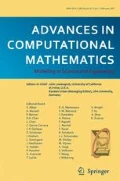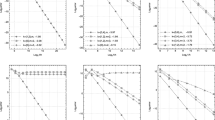Abstract
This paper proposes and investigates a method for reducing potential numerical instability in the fast spherical harmonic transform algorithms proposed previously in [5,11]. The key objective of this study is a numerically reliable fast algorithm for computing the discrete Legendre transform (DLT); that is, the projection of sampled data onto the associated Legendre functions within a specified range of degrees. A simple divide-and-conquer approach derives from a factorization of high-degree Legendre functions into Legendre functions of lower-degree, exploiting the fact that the complexity of projection onto Legendre functions decreases with decreasing degree. Combining the resulting fast DLT algorithms for each relevant order of associated Legendre function results in an O(Nlog 2 N) algorithm for computing the spherical harmonic expansion of a function sampled at N points on the sphere. While fast DLT algorithms of this form are exact in exact arithmetic, actual (finite precision) implementations of the earlier variants display instabilities which generally grow with the the order of the associated Legendre function in the transform. Here we return to the basic algorithm, present a slight modification of the general schema and examine the error mechanism for the higher-order cases. This study suggests a new approach to the high-order DLTs achieved by substitution of a simple alternative factorization of the associated Legendre functions in place of that used previously. This technique improves stability significantly for a wide range of useful problem sizes and may be used with any of the variants of the basic algorithm previously proposed. We present a description of the use of the new Legendre decomposition in the basic fast algorithm along with numerical experiments demonstrating the large advances in stability and efficiency of the new approach over the previous results.
Similar content being viewed by others
References
G. Chirikjian and A. Kyatkin, Engineering Applications of Noncommutative Harmonic Analysis: With Emphasis on Rotation and Motion Groups (Lewis Pub., 2001).
J.W. Cooley and J.W. Tukey, An algorithm for machine calculation of complex Fourier series, Math. Comp. 19 (1965) 297–301.
T.H. Cormen, C.E. Leiserson and R.L. Rivest, Introduction to Algorithms (MIT Press, Cambridge, MA, 1990).
G.A. Dilts, Computation of spherical harmonic expansion coefficients via FFTs, J. Comput. Phys. 57(3) (1985) 439–453.
J.R. Driscoll and D. Healy, Computing Fourier transforms and convolutions on the 2-sphere (extended abstract), in: Proc. of the 34th IEEE FOCS, 1989, pp. 344–349; Adv. in Appl. Math. 15 (1994) 202-250.
J.R. Driscoll, D. Healy and D. Rockmore, Fast discrete polynomial transforms with applications to data analysis for distance transitive graphs, SIAM J. Comput. 26(4) (1997) 1066–1099.
D.F. Elliott and K.R. Rao, Fast Transforms: Algorithms, Analyses, and Applications (Academic Press, New York, 1982).
D. Healy, H. Hendriks and P. Kim, Spherical deconvolution with application to geometric quality assurance, Technical Report, Department of Mathematics and Computer Science, Dartmouth College (1993).
D. Healy and P. Kim, An empirical Bayes approach to directional data and efficient computation on the sphere, Ann. Statist. 24(1) (1996) 232–254.
D. Healy, S. Moore and D. Rockmore, Efficiency and stability issues in the numerical convolution of Fourier transforms and convolutions on the 2-sphere, Technical Report PCS-TR94-222, Department of Computer Science, Dartmouth College (1994).
D. Healy, D. Rockmore, P. Kostelec and S. Moore, FFTs for the 2-sphere-improvements and variations, J. Fourier Anal. Appl., to appear.
M.T. Heideman, D.H. Johnson and C.S. Burrus, Gauss and the history of the fast Fourier transform, Arch. Hist. Exact Sci. 34(3) (1985) 265–277.
R. Jakob-Chien and B.K. Alpert, A fast spherical filter with uniform resolution, J. Comput. Phys. 136 (1997) 580–584.
D. Maslen, Efficient computation of Fourier transforms on compact groups, J. Fourier Anal. Appl. 4(1) (1998) 19–52.
D. Maslen, Fast transforms and sampling for compact groups, Ph.D. thesis, Department ofMathematics, Harvard University (1993).
D. Maslen and D. Rockmore, Generalized FFTs, in: Groups and Computation II, eds. L. Finkelstein and W. Kantor, DIMACS Series in Discrete Mathematics and Theoretical Computer Science, Vol. 28 (Amer. Math. Soc., Providence, RI, 1997) pp. 183–237.
M.P. Mohlenkamp, A fast transform for spherical harmonics, J. Fourier Anal. Appl. 5(2/3) (1999) 159–184.
S. Moore, Efficient stabilization methods for fast polynomial transforms, Ph.D. thesis, Department of Mathematics and Computer Science, Dartmouth College (1994).
S. Moore, D. Healy and D. Rockmore, Symmetry stabilization for polynomial evaluation and interpolation, Linear Algebra Appl. 192 (1993) 249–299.
S. Moore, D. Healy, D. Rockmore and P. Kostelec, SpharmonicKit is a freely available collection of C programs for doing Legendre and scalar spherical transforms, Developed at Dartmouth College, available at www.cs.dartmouth.edu/geelong/sphere/.
A. Oppenheim and R. Schafer, Discrete-Time Signal Processing (Prentice-Hall, Englewood Cliffs, NJ, 1989).
D. Potts, G. Steidl and M. Tasche, Fast and stable algorithms for discrete spherical Fourier transforms, Linear Algebra Appl. 275/276 (1998) 433–450.
D. Rockmore, Some applications of generalized FFTs (appendix with D. Healy), in: Groups and Computation II, eds. L. Finkelstein and W. Kantor, DIMACS Series in Discrete Mathematics and Theoretical Computer Science, Vol. 28 (Amer. Math. Soc., Providence, RI, 1997) pp. 329–369.
SPHEREPACK is a freely available collection of FORTRAN programs that facilitates computer modeling of geophysical processes developed at NCAR by J. Adams and P. Swarztrauber.
W.F. Spotz and P.N. Swarztrauber, A performance comparison of associated Legendre projections, J. Comput. Phys. 168(2) (2001) 339–355.
G. Steidl and M. Tasche, A polynomial approach to fast algorithms for discrete Fourier-cosine and Fourier-sine transforms, Math. Comp. 56 (1991) 281–296.
P.N. Swarztrauber and W.F. Spotz, Generalized discrete spherical harmonic transforms, J. Comput. Phys. 159(2) (2000) 213–230.
C. Temperton, On scalar and vector transform methods for global spectral models, Mon. Wea. Rev. 119 (1991) 1303–1307.
C. Van Loan, Computational Framework for the Fast Fourier Transform (SIAM, Philadelphia, PA, 1992).
N.J. Vilenkin, Special Functions and the Theory of Group Representations (Amer. Math. Soc., Providence, RI, 1968).
N. Yarvin and V. Rokhlin, A generalized one-dimensional fast multipole method with applications to filtering of spherical harmonics, J. Comput. Phys. 147(2) (1998) 5594–5609.
Author information
Authors and Affiliations
Rights and permissions
About this article
Cite this article
Healy, D., Kostelec, P. & Rockmore, D. Towards Safe and Effective High-Order Legendre Transforms with Applications to FFTs for the 2-sphere. Advances in Computational Mathematics 21, 59–105 (2004). https://doi.org/10.1023/B:ACOM.0000016431.03652.65
Issue Date:
DOI: https://doi.org/10.1023/B:ACOM.0000016431.03652.65



